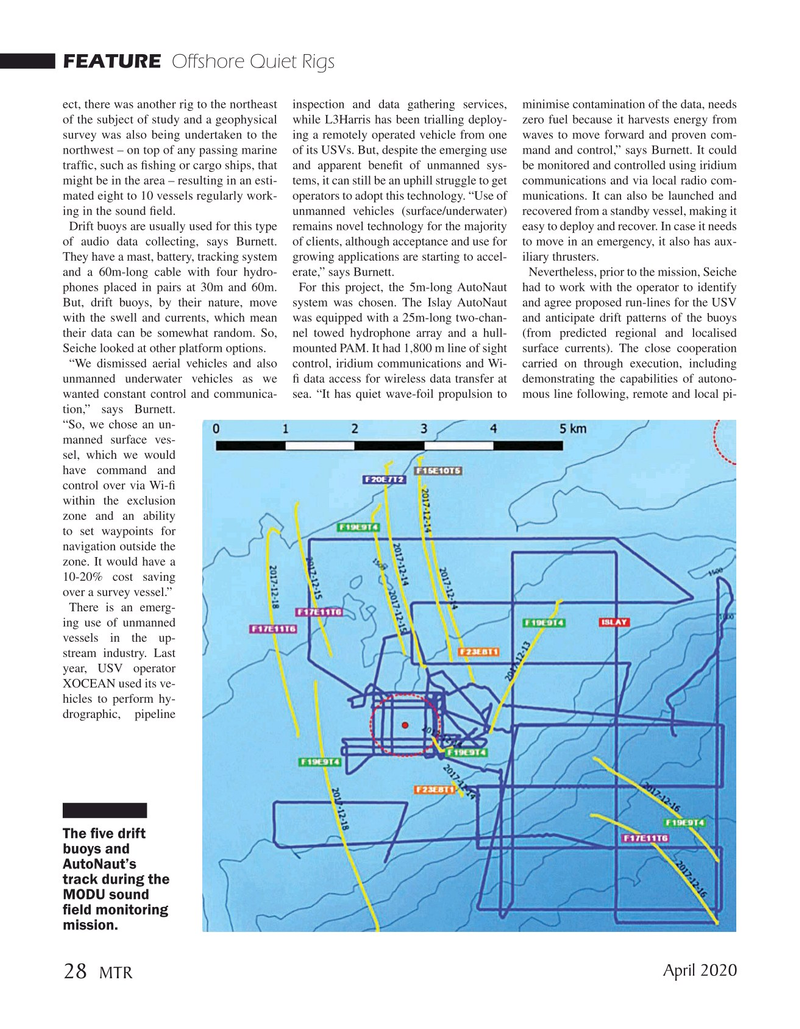
Page 28: of Marine Technology Magazine (April 2020)
Read this page in Pdf, Flash or Html5 edition of April 2020 Marine Technology Magazine
FEATURE Offshore Quiet Rigs ect, there was another rig to the northeast inspection and data gathering services, minimise contamination of the data, needs of the subject of study and a geophysical while L3Harris has been trialling deploy- zero fuel because it harvests energy from survey was also being undertaken to the ing a remotely operated vehicle from one waves to move forward and proven com- northwest – on top of any passing marine of its USVs. But, despite the emerging use mand and control,” says Burnett. It could traffc, such as fshing or cargo ships, that and apparent beneft of unmanned sys- be monitored and controlled using iridium might be in the area – resulting in an esti- tems, it can still be an uphill struggle to get communications and via local radio com- mated eight to 10 vessels regularly work- operators to adopt this technology. “Use of munications. It can also be launched and ing in the sound feld. unmanned vehicles (surface/underwater) recovered from a standby vessel, making it
Drift buoys are usually used for this type remains novel technology for the majority easy to deploy and recover. In case it needs of audio data collecting, says Burnett. of clients, although acceptance and use for to move in an emergency, it also has aux-
They have a mast, battery, tracking system growing applications are starting to accel- iliary thrusters. and a 60m-long cable with four hydro- erate,” says Burnett. Nevertheless, prior to the mission, Seiche phones placed in pairs at 30m and 60m. For this project, the 5m-long AutoNaut had to work with the operator to identify
But, drift buoys, by their nature, move system was chosen. The Islay AutoNaut and agree proposed run-lines for the USV with the swell and currents, which mean was equipped with a 25m-long two-chan- and anticipate drift patterns of the buoys their data can be somewhat random. So, nel towed hydrophone array and a hull- (from predicted regional and localised
Seiche looked at other platform options. mounted PAM. It had 1,800 m line of sight surface currents). The close cooperation “We dismissed aerial vehicles and also control, iridium communications and Wi- carried on through execution, including unmanned underwater vehicles as we f data access for wireless data transfer at demonstrating the capabilities of autono- wanted constant control and communica- sea. “It has quiet wave-foil propulsion to mous line following, remote and local pi- tion,” says Burnett. “So, we chose an un- manned surface ves- sel, which we would have command and control over via Wi-f within the exclusion zone and an ability to set waypoints for navigation outside the zone. It would have a 10-20% cost saving over a survey vessel.”
There is an emerg- ing use of unmanned vessels in the up- stream industry. Last year, USV operator
XOCEAN used its ve- hicles to perform hy- drographic, pipeline
The fve drift buoys and
AutoNaut’s track during the
MODU sound feld monitoring mission. April 2020 28
MTR

 27
27

 29
29
